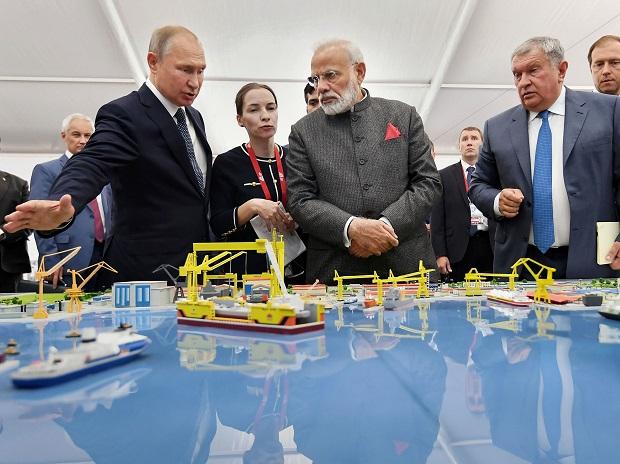
SOURCE: ET
India and Russia riding on goodwill of their partnership in building naval ships are exploring joint efforts in creating civilian shipbuilding industry here including repair facilities besides expediting maritime links through International North South Transport Corridor (INSTC) and Vladivostok-Chennai shipping links.
The two sides eyeing to firm up their maritime partnership discussed avenues of bilateral collaboration in ship design and building, repair, logistics, MRO, inland waterways and ports sectors during a webinar held on Thursday. Russian Deputy Minister Industry and Trade Oleg Ryazantsev and Indian Minister of State for Shipping and Chemical and Fertilizers Mansukh Mandaviya chaired that webinar.
“Hon’ble MoS @mansukhmandviya and Dy Minister Industry & Trade Oleg Ryazantsev chaired a special webinar on Shipping Sector today, discussing avenues of collaboration in ship design & building, repair, logistics, MRO, inland waterways, ports sectors between India and Russia,” Indian Embassy in Russia tweeted.
Indian Ambassador to Russia D.B. Venkatesh Varma who also addressed the webinar stressed on immense opportunities for bilateral cooperation. The participants of the webinar included the Chairpersons of Chennai Port Trust and IWAI, Secretary Shipping, Trade Commissioner of Russia to India.
The Indo-Russian MRO partnership in the shipping sector will be a win-win proposition with 30,000 ships visiting Indian ports annually, a source pointed out.
The Indo-Russian maritime partnership got a boost with the last annual summit held in Vladivostok. Besides, expediting INSTC that aims to connect Mumbai with St Petersburg via Indian Ocean and then via Iran and Azerbaijan, revival of Chennai-Vladivostok shipping link is also on the cards. While Delhi seeks an inclusive Indo-Pacific region with participation of Russia, Moscow is exploring to increase its presence in the region which currently remains limited in scope.
This shipping link that existed during the Soviet Union period would enable to transfer cargo between Chennai and Vladivostok in 24 days compared to over 40 days currently taken to transport goods from India to Far East Russia via Europe. This shipping link will also help India to expand its footprints in Far East Russia based on Act Far East policy.
Far East Russia has a wealth of natural resources such as land, timber, mineral and other resources like tin, gold, diamonds and oil and natural gas. The Russian government has announced several initiatives to attract investments in the region, including an agricultural SEZ, the Vladivostok Free Port Project and also invites participation in the timber industry, mining of the huge mineral resources (coal & diamonds) and precious metal deposits (gold, platinum, tin and tungsten).
India also plans to explore connectivity corridor between resource rich Arctic Region and INSTC. India is interested in development of infrastructure, shipping route and harnessing of minerals in Arctic region in a sustainable manner.
Delhi has been in dialogue with Russia cooperation in connectivity via the Northern Sea Route and joint energy projects in Arctic region.
The Arctic contains a wealth of petroleum and mineral resources. Currently, the region produces about one tenth of the world’s oil and a quarter of its natural gas. The Russian Arctic is the source for about 80 percent of this oil and virtually all of the natural gas. The most developed sector of the region, the Russian Arctic also holds abundant deposits of nickel, copper, coal, gold, uranium, tungsten, and diamonds.
The Northern Sea Route – is the main sea route in the Russian Arctic. The Route crosses seas of the Arctic Ocean (Kara, Laptev, East Siberian and Chukotka) and partially the Pacific Ocean (the Bering Sea). The Northern Sea Route from the Kara Gate to the Providence Bay is about 5,600km long. The distance between St. Petersburg to Vladivostok along the Northern Sea Route is more than 14,000 km, while the distance vessels have to cover by the Suez Canal is more than 23,000 km.






